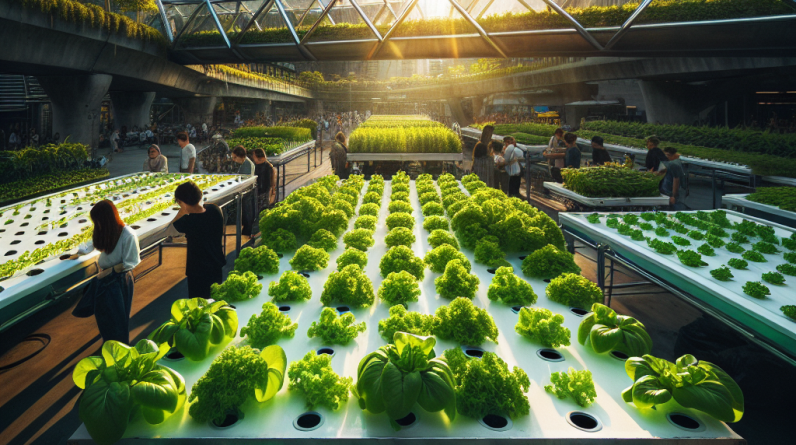
Maximizing Space in Urban Areas
Understanding Hydroponics and Its Benefits
When I first stumbled upon hydroponics, I was blown away by how much potential it held for city living. It’s all about growing plants without soil, which makes it perfect for urban spaces where every inch counts. Imagine setting up a garden on your balcony or even indoors. It’s a game changer!
One of the coolest things about hydroponics is that it uses significantly less water compared to traditional farming. You’re not just saving space; you’re also conserving our precious water resources. I mean, who doesn’t want to grow fresh basil without feeling guilty about wasting water?
Additionally, hydroponics allows for year-round growing. That’s right! No more waiting for spring to get your herb garden going. With controlled environments, I can have fresh produce right in my kitchen, regardless of the season. It’s like having my very own mini supermarket!
Eco-Friendly Practices
Reducing Carbon Footprint
I’ve always been passionate about sustainability, and hydroponics truly aligns with that. By growing food closer to where it’s consumed, we can cut down on transportation emissions. Just think about it: virtually no more semi-trucks delivering veggies from thousands of miles away!
Moreover, many urban hydroponics setups utilize renewable energy sources like solar power. It’s incredible to picture homes and community gardens powered by the sun. I’ve tried using solar panels on my own setup, and let me tell you, the satisfaction of producing my own power is simply amazing.
Hydroponics also drastically reduces the need for pesticides and herbicides, as the controlled environment makes it harder for pests to thrive. I’ve seen my own plants flourish without the harsh chemicals that many farms rely on. It’s reassuring knowing I can enjoy fresh produce without worrying about what might be lurking on my salad.
Community and Connection
Bringing Neighbors Together
One of the best parts about my hydroponic journey has been sharing it with my community. Setting up a collective garden in my neighborhood not only helped us produce our own food, but it also became a hub for connection. We’ve turned strangers into friends through our love of gardening!
We host monthly workshops where we all gather to learn more about hydroponics. It’s amazing to see kids and adults alike come together, getting their hands dirty and sharing tips and tricks. There’s something truly special about bonding over a shared goal, don’t you think?
Plus, when we’re harvesting our produce together, the excitement is palpable. It’s a satisfying feeling to know that we’ve contributed to our community’s food security, and it really brings everyone closer together.
Accessible Technology
Simple Hydroponics Systems to Start With
If you’re thinking about diving into hydroponics, don’t let the fancy tech intimidate you! There are plenty of super simple systems that even a novice can manage. When I got started, I opted for a basic DIY setup made with PVC pipes and a water pump. Total budget-friendly!
You can easily find kits online that have everything you need to get started. I’ve even seen folks using recycled materials to create their systems. It feels great knowing I’m reducing waste and growing fresh food at the same time. Plus, it gives you that DIY satisfaction!
Even with simple systems, the learning curve can be a lot of fun. I’ve made plenty of mistakes, but each failure teaches me something new. And guess what? The joy of finally seeing my first lettuce heads bursting from the nutrient solution made it all worth it!
Health Benefits of Growing Your Own Food
Nutritional Advantages
Growing my own food through hydroponics has had a huge impact on my diet. The freshness of home-grown produce is unbeatable. Whenever I snip herbs or vegetables from my setup, I know they’re packed with nutrients because I’ve harvested them at their peak!
Did you know that some studies suggest that home-grown food can have higher nutrient levels compared to store-bought? I’ve noticed a difference in flavor, and I’m sure it’s tied to the freshness of my greens. It’s amazing how good food can taste when you have a hand in growing it.
Furthermore, my health has improved since I started this journey. I’m more mindful of what I eat, and I’m excited to throw together meals with fresh ingredients. The satisfaction of knowing that I have control over what I consume is incredibly empowering!
FAQ
What is hydroponics?
Hydroponics is a method of growing plants without soil, using nutrient-rich water instead. It’s effective for maximizing space, particularly in urban settings.
Can I grow food indoors using hydroponics?
Absolutely! Hydroponics is perfect for growing plants indoors, as it allows for controlled environments and year-round cultivation.
Is hydroponics eco-friendly?
Yes! Hydroponics generally uses less water and reduces the need for harmful pesticides, making it a more sustainable option for food production.
Do I need special equipment to start hydroponics?
While there are advanced systems available, you can start with simple, cost-effective setups using materials you might already have at home, like PVC pipes!
What types of plants can I grow in a hydroponics system?
Almost any plant can be grown hydroponically, but leafy greens, herbs, and strawberries are great choices for beginners!








